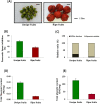Comparison of pancreatic lipase inhibitory isoflavonoids from unripe and ripe fruits of Cudrania tricuspidata
- PMID: 28253267
- PMCID: PMC5333804
- DOI: 10.1371/journal.pone.0172069
Comparison of pancreatic lipase inhibitory isoflavonoids from unripe and ripe fruits of Cudrania tricuspidata
Abstract
The composition and content of the active constituents and their biological activity vary according to diverse factors including their maturation stages. A previous study showed that the fruits of Cudrania tricuspidata inhibited pancreatic lipase activity, a key enzyme in fat absorption. In this study, we investigated the chemical composition and pancreatic lipase inhibitory activity of unripe and ripe fruits of C. tricuspidata. Unripe fruits of C. tricuspidata have a higher content of total phenolic and flavonoids and exhibited stronger pancreatic lipase inhibition compared to ripe fruits. HPLC analysis revealed the different chemical compositions of the unripe and ripe fruits. Further fractionation resulted in the isolation of 30 compounds including two new isoflavonoids. Analysis of the chemical constituents of the unripe and ripe fruits revealed that a 2,2-dimethylpyran ring, a cyclized prenyl, was the predominant side chain in the unripe fruits, whereas it was a linear prenyl group in the ripe fruits. In addition, a new isoflavonoid (19) from the unripe fruits showed the most potent inhibition on pancreatic lipase. Taken together, the maturation stage is an important factor for maximum efficacy and that unripe fruits of C. tricuspidata are a good source of new bioactive constituents for the regulation of obesity.
Conflict of interest statement
Figures






Similar articles
-
Optimization of pancreatic lipase inhibition by Cudrania tricuspidata fruits using response surface methodology.Bioorg Med Chem Lett. 2014 May 15;24(10):2329-33. doi: 10.1016/j.bmcl.2014.03.067. Epub 2014 Apr 1. Bioorg Med Chem Lett. 2014. PMID: 24751440
-
Anti-α-glucosidase and anti-oxidative isoflavonoids from the immature fruits of Maclura tricuspidata.Phytochemistry. 2022 Feb;194:113016. doi: 10.1016/j.phytochem.2021.113016. Epub 2021 Nov 15. Phytochemistry. 2022. PMID: 34794092
-
Benzylated and prenylated flavonoids from the root barks of Cudrania tricuspidata with pancreatic lipase inhibitory activity.Bioorg Med Chem Lett. 2015 Sep 1;25(17):3455-7. doi: 10.1016/j.bmcl.2015.07.017. Epub 2015 Jul 17. Bioorg Med Chem Lett. 2015. PMID: 26227773
-
Bioactive compounds from Cudrania tricuspidata: A natural anticancer source.Crit Rev Food Sci Nutr. 2020;60(3):494-514. doi: 10.1080/10408398.2018.1541866. Epub 2018 Dec 22. Crit Rev Food Sci Nutr. 2020. PMID: 30582344 Review.
-
Polyphenolic Compounds as Pancreatic Lipase Inhibitors.Planta Med. 2015 Jul;81(10):771-83. doi: 10.1055/s-0035-1546173. Epub 2015 Jul 1. Planta Med. 2015. PMID: 26132857 Review.
Cited by
-
Derrone induces autophagic cell death through induction of ROS and ERK in A549 cells.PLoS One. 2019 Jun 19;14(6):e0218659. doi: 10.1371/journal.pone.0218659. eCollection 2019. PLoS One. 2019. PMID: 31216334 Free PMC article.
-
Antibacterial Activities of Prenylated Isoflavones from Maclura tricuspidata against Fish Pathogenic Streptococcus: Their Structure-Activity Relationships and Extraction Optimization.Molecules. 2021 Dec 9;26(24):7451. doi: 10.3390/molecules26247451. Molecules. 2021. PMID: 34946533 Free PMC article.
-
Alpinumisoflavone ameliorates choroidal neovascularisation and fibrosis in age-related macular degeneration in in vitro and in vivo models.Sci Rep. 2022 Aug 22;12(1):14316. doi: 10.1038/s41598-022-18531-y. Sci Rep. 2022. PMID: 35995845 Free PMC article.
-
The Growth Characteristics and the Active Compounds of Cudrania tricuspidata Fruits in Different Cultivation Environments in South Korea.Plants (Basel). 2023 May 25;12(11):2107. doi: 10.3390/plants12112107. Plants (Basel). 2023. PMID: 37299087 Free PMC article.
-
Anti-Metastatic Effect of Gold Nanoparticle-Conjugated Maclura tricuspidata Extract on Human Hepatocellular Carcinoma Cells.Int J Nanomedicine. 2020 Jul 27;15:5317-5331. doi: 10.2147/IJN.S246724. eCollection 2020. Int J Nanomedicine. 2020. PMID: 32904434 Free PMC article.
References
-
- Ballinger A, Peikin SR. Orlistat: its current status as an anti-obesity drug. Eur. J. Pharmacol. 2002; 440: 109–117. - PubMed
Publication types
MeSH terms
Substances
LinkOut - more resources
Full Text Sources
Other Literature Sources

